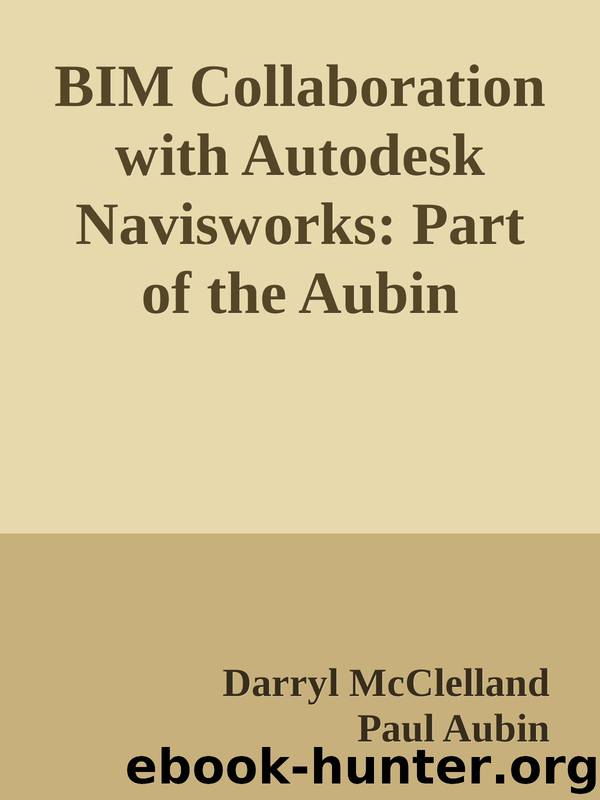BIM Collaboration with Autodesk Navisworks: Part of the Aubin Academy Master Series, covers version 2015 by Darryl McClelland & Paul Aubin

Author:Darryl McClelland & Paul Aubin [McClelland, Darryl]
Language: eng
Format: epub
Publisher: G3B Press
Published: 2015-03-12T18:30:00+00:00
• Understanding Navisworks •
128 | Chapter 5
QUICK REFERENCE FOR THE COLLISION DIALOG
The collision dialog contains several customizable settings. We explored a few in the
tutorial above. Here is a complete list for your ongoing reference.
Collision dialog settings:
Collision—Select this option to define a volume or mass to the Viewer that
will be used to identify collisions in the project model when the Walk or Fly
tool has been activated. This will prevent the mass from passing through
certain objects or lines in the Scene View.
Gravity—Select this option to provide “weight” to the Viewer when the Walk
tool has been activated. This option works in conjunction with Collision.
Auto Crouch—Select this option to enable the Viewer to crouch under objects
in the model that are normally too low to pass under when the Walk tool has
been activated. This option works in conjunction with Collision.
Viewer—An invisible volume located in front of the camera in the Scene View.
Radius—Define the radius of the Viewer volume that will be used to
detect collisions in the Navisworks model.
Height—Define the height of the Viewer volume that will be used to
detect collisions in the Navisworks model.
Eye Offest—Define the distance below the top of the Viewer volume
(Height) where the Viewer will focus if Auto Zoom is selected.
Third Person—When enabled, an avatar will be used to represent a building
occupant in lieu of the Viewer. This avatar can also help identify collisions
with building components.
Enable—Select this option to use the Third person view. When an Avatar
has been selected from the drop-down, it will be shown in the Scene View
to represent the Viewer.
Auto Zoom—Select this option to automatically switch from the Third
Person view to the Viewer whenever the Third Person view becomes
obstructed by an object.
Avatar—Use the drop-down to select the Avatar that will be used in the
Third Person view and applied to the Scene View.
Angle—Specify the camera angle of the camera looking at the avatar. For
example, 0°will place the camera directly behind the Avatar while 15° will
be the camera looking down on the avatar at a 15° angle.
Distance—Define the distance between the camera and the avatar.
Download
This site does not store any files on its server. We only index and link to content provided by other sites. Please contact the content providers to delete copyright contents if any and email us, we'll remove relevant links or contents immediately.
The Body: A Guide for Occupants by Bill Bryson(4974)
Audition by Ryu Murakami(4850)
Adulting by Kelly Williams Brown(4487)
Housekeeping by Marilynne Robinson(4347)
Be in a Treehouse by Pete Nelson(3947)
Zero Waste Home by Bea Johnson(3778)
Seriously... I'm Kidding by Ellen DeGeneres(3577)
Better Homes and Gardens New Cookbook by Better Homes & Gardens(3525)
The Healing Self by Deepak Chopra(3474)
Barkskins by Annie Proulx(3313)
Hedgerow by John Wright(3276)
The Cellar by Natasha Preston(3262)
Spark Joy by Marie Kondo(3249)
The Genius of Japanese Carpentry by Azby Brown(3224)
The Life-Changing Magic Of Tidying Up- The Japanese Art Of Decluttering And Organizing (v5.0) by Marie Kondo(3211)
120 Days of Sodom by Marquis de Sade(3180)
Work Clean by Dan Charnas(3048)
The Book of Numbers by Peter Bentley(2912)
A Monk's Guide to a Clean House and Mind by Shoukei Matsumoto(2868)
